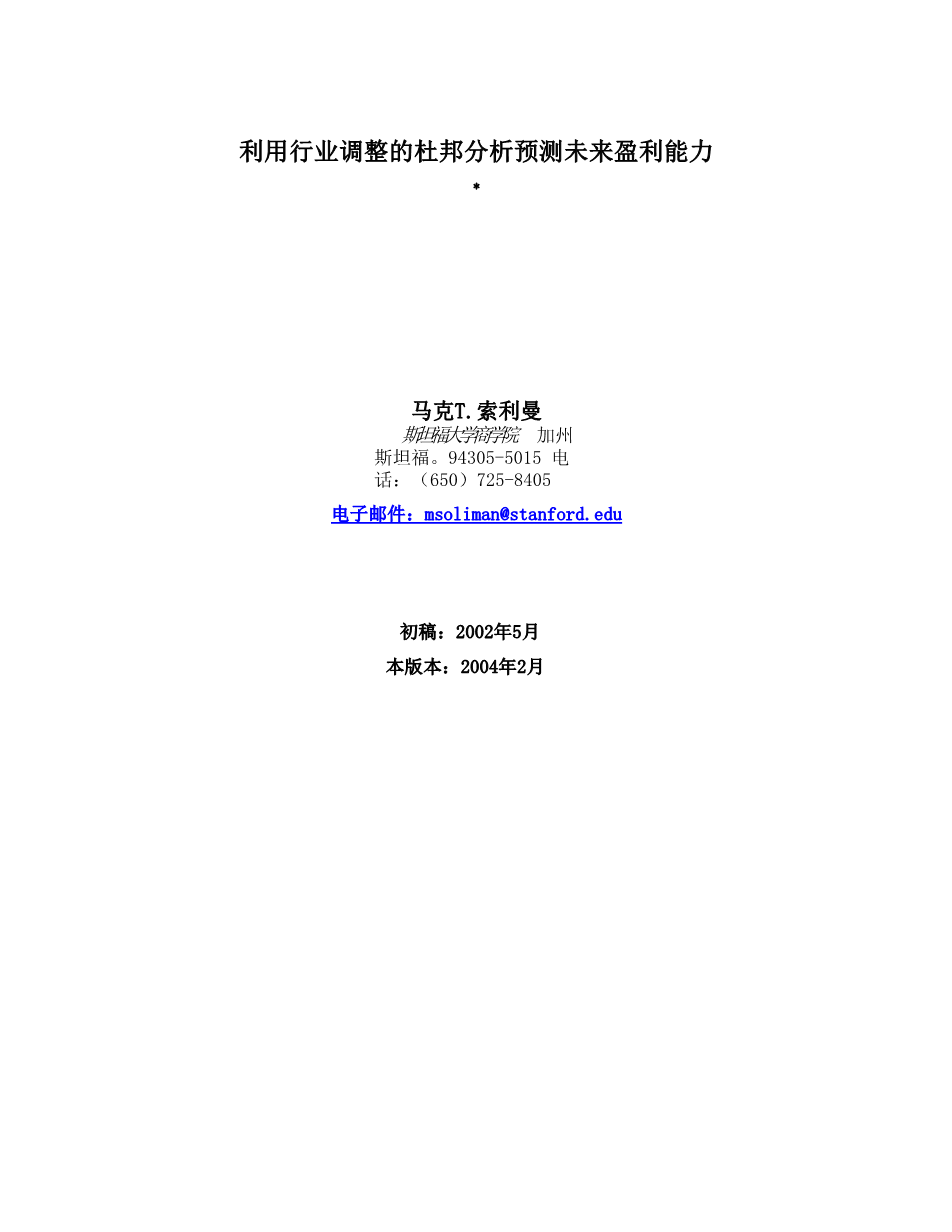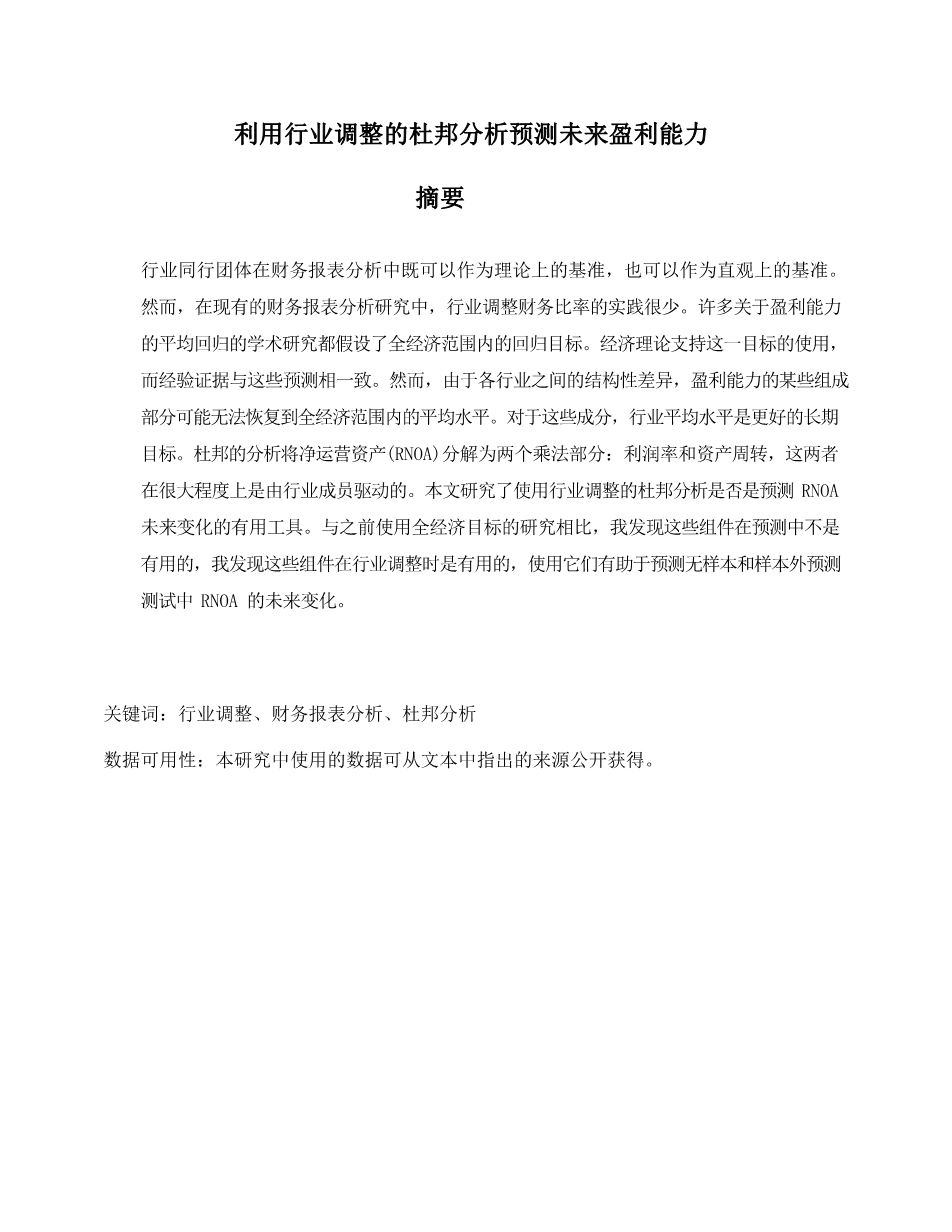Using Industry-Adjusted DuPont Analysis to Predict Future Profitability*
Mark T. Soliman
Graduate School of Business, Stanford University
Stanford, Ca. 94305-5015
Phone (650) 725-8405
Email: msoliman@stanford.edu
First Draft: May 2002 This Version: February 2004
- This paper is based in part on my dissertation at the University of Michigan. I would like to thank the members of my committee: Christopher Achen, Allan Afuah, Patricia Dechow, Russell Lundholm (Chair), and Richard Sloan. I would also like to thank Bill Beaver, Mark Bradshaw, Ilia Dichev, Jeffrey Doyle, Michelle Hanlon, Maureen McNichols, Sarah McVay, Venky Nagar, Scott Richardson, Cathy Shakespeare, Susan Shevlin, Doug Skinner, Irem Tuna and the doctoral students at the University of Michigan for their helpful discussions and comments. This paper has also benefited greatly from the comments of workshop participants at Columbia University, University of California-Berkeley, University of Chicago, Duke University, MIT, Northwestern, University of Pennsylvania, Stanford University, and the University of Southern California. I gratefully acknowledge the financial support of the University of Michigan Business School, the William A. Paton Accounting Fund and the Graduate School of Business at Stanford University.
Using Industry-Adjusted DuPont Analysis to Predict Future Profitability
Abstract:
Industry peer groups serve as both a theoretical and an intuitive benchmark in financial statement analysis. However, the practice of industry-adjusting financial ratios is sparse in existing financial statement analysis research. Much of the academic research on the mean reversion of profitability assumes economy-wide reversion targets. Economic theory supports the use of this target and empirical evidence is consistent with these predictions. However, some components of profitability may not revert to economy-wide averages because of structural differences across industries. For these components, industry averages serve as better long-term targets. DuPont analysis decomposes return-on-net-operating assets (RNOA) into two multiplicative components: profit margin and asset turnover, both of which are largely driven by industry membership. This paper investigates whether using industry-adjusted DuPont analysis is a useful tool in predicting future changes in RNOA. In contrast to prior research that used economy-wide targets and finds that these components are not useful in forecasting, I find that these components are informative when industry-adjusted and that using them helps predict future changes in RNOA in both in- sample and out-of-sample forecasting tests.
Keywords: Industry Adjustment, Financial Statement Analysis, DuPont Analysis
Data Availability: The data used in this study are publicly available from the sources indicated in the text.
JEL classification: M4
INTRODUCTION
Comparing a firmrsquo;s financial ratios with those of an industry peer group is common practice. It has long been established that financial ratios tend toward industry averages because of competitive factors. This concept is based on the notion that industry averages represent some type of “optimal” operating structure. For this reason, analysts often study firms in the context of industry peer groups and specialize in particular industries. Most analystsrsquo; reports begin with an in-depth analysis of the industry as a whole, before discussing the specific firm. Financial statement textbooks promulgate this type of industry comparison as a method of analyzing a firmrsquo;s financial statements [Palepu, Healy, and Bernard (2000)]. Financial portals such as Yahoo! Finance or Marketguide, and stock valuation software such as StockVal, AGIView, and eVal, offer industry benchmarks as a point of comparison for an individual firm. Yet there is limited academic evidence supporting the contention that industry information is useful in forecasting. This paper attempts to shed light on some fundamental questions: Why is industry adjustment useful? What types of analysis can it benefit the most? And ultimately, can it actually improve the forecasts of earnings?
Although the use of industry benchmarks is widespread in practice, the majority of academic research on the mean reversion of profitability measures implicitly assumes an economy-wide benchmark by pooling over the entire cross-section of firms [e.g., Brooks and Buckmaster 1976; Freeman, Ohlson and Penman 1982; Penman 1991; Lipe and Kormendi 1994; Fama and French 2000; Nissim and Penman 2001].1 These papers are based on the notion that Stigler (1963) espouses, “There is no more important proposition in economic theory than that, under competition, the rate of return on investment tends toward equality in all industries.”
Although total profitability measures such as return-on-net-operating assets (RNOA hereafter) may revert to economy-wide benchmarks, there is good reason to believe that the various components of RNOA identified by DuPont analysis will not revert to economy-wide levels.2 Industries have unique operating structures that cause ratios to cluster by industry membership. For example, to compare the sales/assets ratio of a firm in the airline industry with that of a consulting business would be futile because of differences in the way these two industries generate sales. White, Sondhi, and Fried (1998, p.190) and Nissim and Penman (2001) show that the industry medians of
剩余内容已隐藏,支付完成后下载完整资料


英语译文共 9 页,剩余内容已隐藏,支付完成后下载完整资料
资料编号:[602502],资料为PDF文档或Word文档,PDF文档可免费转换为Word
您可能感兴趣的文章
- 饮用水微生物群:一个全面的时空研究,以监测巴黎供水系统的水质外文翻译资料
- 步进电机控制和摩擦模型对复杂机械系统精确定位的影响外文翻译资料
- 具有温湿度控制的开式阴极PEM燃料电池性能的提升外文翻译资料
- 警报定时系统对驾驶员行为的影响:调查驾驶员信任的差异以及根据警报定时对警报的响应外文翻译资料
- 门禁系统的零知识认证解决方案外文翻译资料
- 车辆废气及室外环境中悬浮微粒中有机磷的含量—-个案研究外文翻译资料
- ZigBee协议对城市风力涡轮机的无线监控: 支持应用软件和传感器模块外文翻译资料
- ZigBee系统在医疗保健中提供位置信息和传感器数据传输的方案外文翻译资料
- 基于PLC的模糊控制器在污水处理系统中的应用外文翻译资料
- 光伏并联最大功率点跟踪系统独立应用程序外文翻译资料



